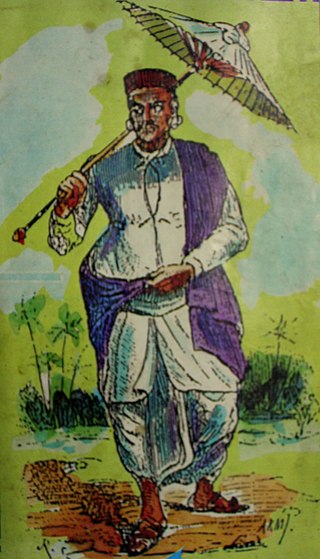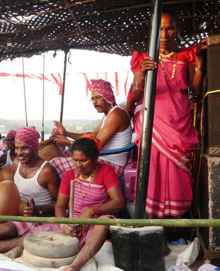
The Konkan is a stretch of land by the western coast of India, bound by the river Daman Ganga at Damaon in the north, to Anjediva Island next to Karwar town in the south; with the Arabian Sea to the west and the Deccan plateau to the east. The hinterland east of the coast has numerous river valleys, riverine islands and the hilly slopes known as the Western Ghats; that lead up into the tablelands of the Deccan. The region has been recognised by name, since at least the time of Strabo in the third century CE. It had a thriving mercantile port with Arab tradesmen from the 10th century. The best-known islands of Konkan are Ilhas de Goa, the site of the Goa state's capital at Panjim, and the Seven Islands of Bombay, on which lies Mumbai, the capital of Maharashtra and the headquarters of the Konkan Division.

Canacona is an administrative region in the district of South Goa, Goa state, India.

The Goa Inquisition was an extension of the Portuguese Inquisition in Portuguese India. Its objective was to enforce Catholic orthodoxy and allegiance to the Holy See. Conversions took place through the Goan Inquisition with the persecution of Hindus and the destruction of Hindu temples.

Kunbi is a generic term applied to several castes of traditional farmers in Western India. These include the Dhonoje, Ghatole, Masaram, Hindre, Jadav, Jhare, Khaire, Lewa, Lonare and Tirole communities of Vidarbha. The communities are largely found in the state of Maharashtra but also exist in the states of Madhya Pradesh, Gujarat, Karnataka, Kerala and Goa. Kunbis are included among the Other Backward Classes (OBC) in Maharashtra.
Shuddhi is Sanskrit for purification. It is a term used to describe a Hindu religious movement aimed at the religious conversion of non-Hindus of Indian origin to Hinduism.
The Dhangars are a herding caste of people found in the Indian states of Maharashtra, Karnataka, Goa, Madhya Pradesh and Uttar Pradesh. They are referred as Gavli in southern Maharashtra, Goa and northern Karnataka, Golla in Andhra Pradesh and Karnataka and Ahir in northern Maharashtra. Some Gavlis live in forested hill tracts of India's Western Ghats. Gavli, also known as Dange or Mhaske, and Ahir are a sub-caste of Dhangar. However, there are many distinct Gavli castes in Maharashtra and Dhangar Gavli is one of them.
The Konkani people are an Indo-Aryan ethnolinguistic group native to the Konkan region of the Indian subcontinent who speak various dialects of the Konkani language. Konkani is the state language of Goa and also spoken by populations in Karnataka, Maharashtra, Damaon and Kerala. Other Konkani speakers are found in Gujarat state. A large percentage of Konkani people are bilingual.
The caste system in Goa consists of various Jātis or sub-castes found among Hindus belonging to the four varnas, as well as those outside of them. A variation of the traditional Hindu caste system was also retained by the Goan Catholic community.
Goan Catholics are an ethno-religious community of Indian Christians adhering to the Latin Rite of the Catholic Church from the Goa state, in the southern part of the Konkan region along the west coast of India. They are Konkani people and speak the Konkani language.

Hinduism is the majority religion of people living in Goa. According to the 2011 census, in a population of 1,458,545 people, 66.08% were Hindu.
Goans is the demonym used to describe the people native to Goa, India, who form an ethno-linguistic group resulting from the assimilation of Indo-Aryan, Dravidian, Indo-Portuguese, Austro-Asiatic ethnic and/or linguistic ancestries. They speak different dialects of the Konkani language, collectively known as Goan Konkani. "Goanese", although sometimes used, is an incorrect term for Goans.

The Daivadnya,, is a community from Goa and Karnataka, who claim to have descended from Vishwakarma. Although they claim themselves to be Brahmin, but these claims are not accepted by others including local Brahmin castes. They are native to the Konkan and are mainly found in the states of Goa and Damaon, Canara, coastal Maharashtra, and Kerala. Daivadnyas in the state of Maharashtra and Karnataka are classified by National Commission for Backward Classes as an Other Backward Class.
The Kudumbi, also referred to as the Kunubis, the Kurumbi, or the Kunbi, are traditionally a Konkani-speaking farming community residing in Kerala, India.
Roman Catholic Brahmin is a caste among the Goan, Bombay East Indian and Mangalorean Catholics who are descendants of Konkani Brahmin converts to the Latin Catholic Church, in parts of the Konkan region that were annexed into the Portuguese East Indies, with the capital (metropole) at Velha Goa, while Bombay was the largest territory (province) of Portuguese India. They retain some of the ethno-social values and customs of their ancestors, and most of them exhibit a noticeable hybrid Latino-Concanic culture. They were known as the Brahmins among the "New Christians".
Gomantak Maratha Samaj is a Hindu community found in the Indian state of Goa. They are known as Nutan Maratha Samaj in the Sindhudurg district of Maharashtra and Naik Maratha Samaj in Maharashtra, Uttara Kannada district of Karnataka, also Telangana respectively.

The indigenous population of the erstwhile Portuguese colony of Goa, Daman and Diu underwent Christianisation following the Portuguese conquest of Goa in 1510, which was followed by the Goa Inquisition from 1560 onwards. The converts in the Velhas Conquistas to Roman Catholicism were then granted full Portuguese citizenship. Almost all present-day Goan Catholics are descendants of these native converts; they constitute the largest Indian Christian community of Goa state and account for 25 percent of the population.

The Christian population of Goa is almost entirely Goan Catholics, whose ancestors converted to Christianity during the Portuguese rule in India. Christianisation followed the Portuguese conquest of Goa in 1510, which was followed by the Goa Inquisition from 1560 onwards. The Hindu population is mostly descended from immigrants from other states of India, who have been arriving in Goa since the last century There is a higher proportion of Christians in Velhas Conquistas than in Novas Conquistas.

Luso-Indians or Portuguese-Indian, is a subgroup of the larger Eurasian multiracial ethnic creole people of Luso-Asians. Luso-Indians are people who have mixed Indian and Portuguese ancestry or people of Portuguese descent born or living or originating in former Portuguese Indian colonies, the most important of which were Goa and Damaon of the Konkan region in the present-day Republic of India, and their diaspora around the world, the Anglosphere, Lusosphere, the Portuguese East Indies such as Macao etc.

Alexander Henn is a German anthropologist and Professor for Religious Studies at the School of Historical, Philosophical & Religious Studies Arizona State University in Tempe, Arizona. He is also known for his research done on religion in Goa, India.
Crypto-Hinduism is the secret adherence to Hinduism while publicly professing to be of another faith; practitioners are referred to as "crypto-Hindus". Crypto-Hinduism was observed during a period of forced religious conversions in South Asia, as well as suspected against Hindus who were forcibly converted to the religion of the invaders or colonizers. Many crypto-Hindus were arrested for practicing Hinduism after professing to have converted to Christianity, some sentenced to death for being a crypto-Hindu such as in colonial Portuguese Goa.










